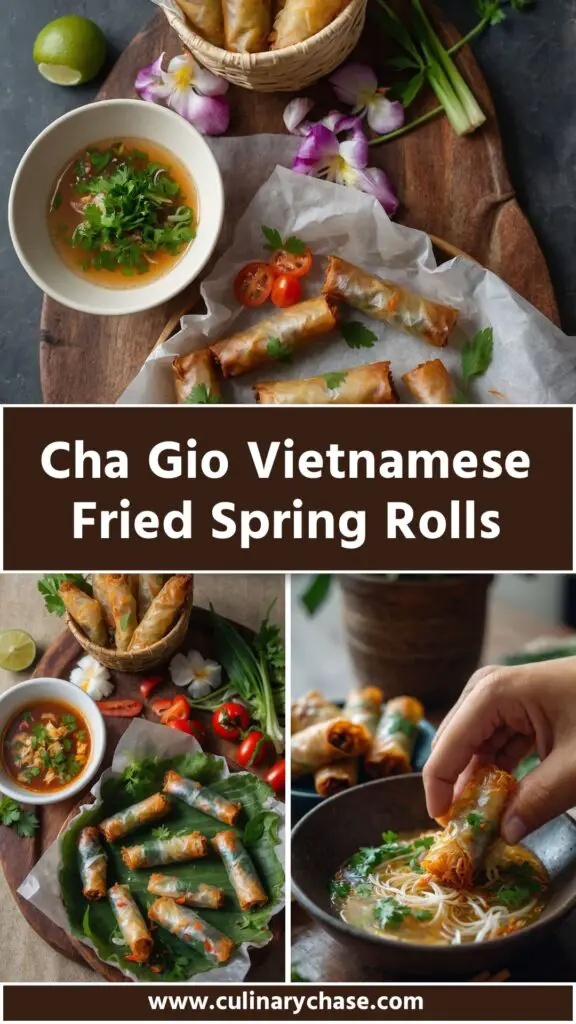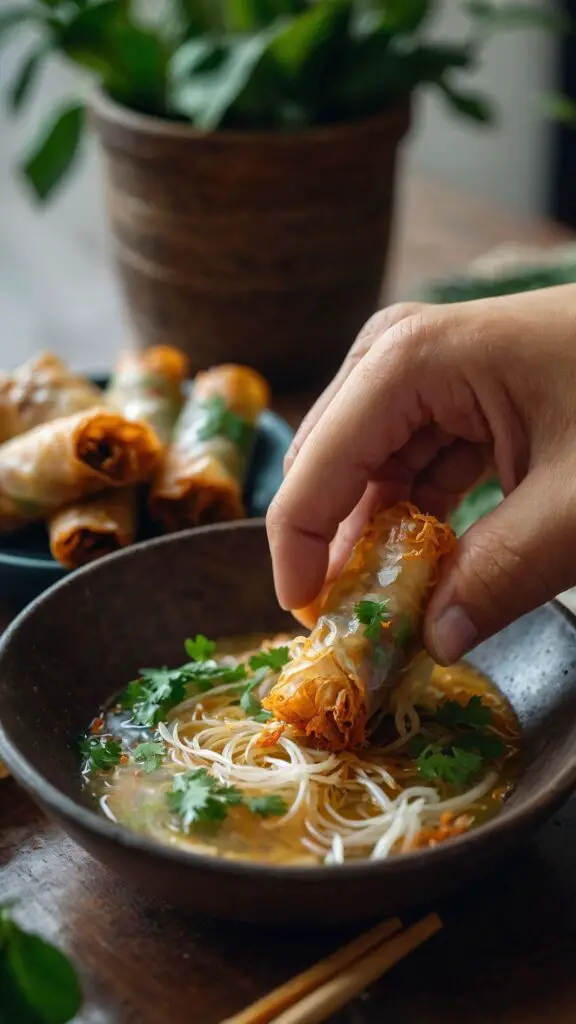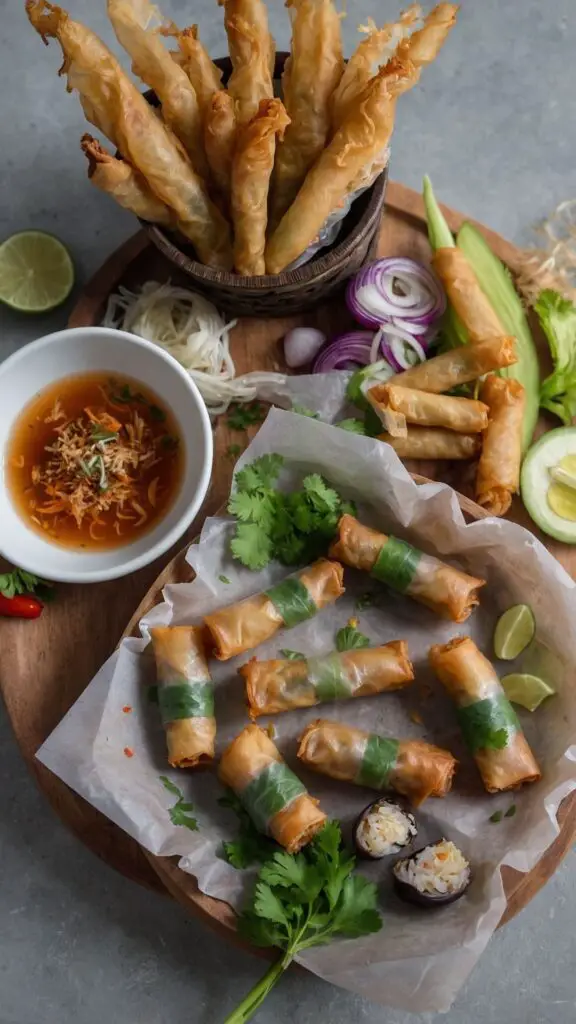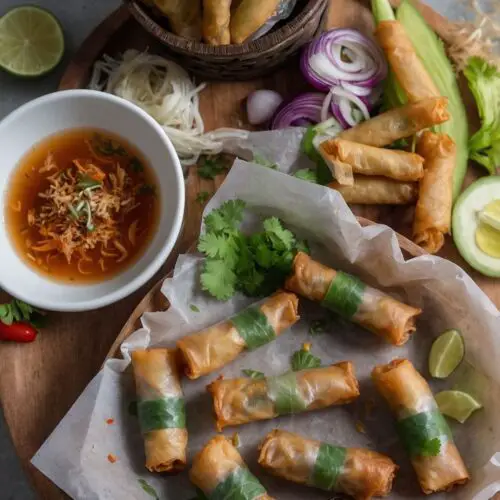Cha Gio Vietnamese Fried Spring Rolls – Culinary Chase
Are you looking for the perfect afternoon snack or a delightful appetizer to impress your friends? Look no further than cha gio, Vietnamese fried spring rolls that pack a flavorful punch. These delicious bites, often filled with a savory mix of ground pork, vegetables, and spices, are simple to make and absolutely scrumptious.
Now, you might be wondering what else pairs well with these little delights. Cha gio is fantastic with a refreshing salad or a savory soup. A light Vietnamese coriander salad can cut through the richness of the spring rolls, while a soothing bowl of pho warms the soul. And don’t forget that dipping sauce! The sharp tang and richness of nuoc cham (a dipping sauce made from fish sauce, lime juice, sugar, and garlic) lifts the whole experience. Let’s dive in!

What Is Cha Gio?
Cha gio, or Vietnamese fried spring rolls, are crispy morsels often enjoyed at family gatherings, festive occasions, or simply as a snack.
Traditionally, these rolls are filled with a variety of ingredients, most commonly ground pork, shrimp, and a medley of vegetables and rice noodles, all wrapped in delicate rice paper and deep-fried to golden perfection.
You will also like the following Appetizers recipes!
Why This Recipe Works
Balanced Flavor Profiles: Each filling ingredient offers a unique taste, resulting in a delightful blend. The pork brings a savory depth, the vegetables add a pleasant crunch, and the spices elevate the overall flavor.
Textural Delight: The contrast between the crispy exterior and the soft, flavorful filling creates an enjoyable eating experience. This play on textures is delightful in every bite.
Customizable Ingredients: You can easily alter the filling based on what you have on hand or personal preferences. This recipe allows you to express creativity.
Make Ahead and Freeze: Preparation doesn’t have to be done on the day of serving. You can prepare the rolls in advance, freeze them, and fry them fresh for unexpected guests or frequent cravings.

Ingredients You’ll Need to Make This Dish
Here’s a handy shopping list for your next trip to the market:
For the Spring Rolls
- 1 tablespoon vegetable oil
- 1 tablespoon fish sauce
- 1/3 cup rehydrated wood ear mushrooms, finely chopped (about 30g)
- 1 teaspoon ginger, grated
- 1 cup warm water (for soaking rice wrappers, about 250 ml)
- 1/2 teaspoon salt
- 2 medium carrots, grated (around 190g)
- 3 teaspoons sugar (12g, divided)
- 1 pound ground pork (70-80% lean, about 450g)
- 1 tablespoon chopped scallions (optional)
- 50 g dried mung bean noodles (1 package)
- 1 clove garlic, minced
- 1 egg white
- 1/4 teaspoon ground white pepper
- 1/4 cup shallots, finely chopped (about 30g)
- 1/2 teaspoon sesame oil (optional)
- 20 dried rice paper wrappers (bánh tráng)
- Canola or vegetable oil (for frying)
To Serve
- Nuoc cham dipping sauce (check out a detailed recipe for this!)
- Fresh green leaf lettuce, cilantro, Thai basil, and mint for a fresh accompaniment.
How to Make Cha Gio: A Step-by-Step Guide
Let’s roll up our sleeves and dive into the making of these fragrant spring rolls.
Step 1: Prepare the Filling
Start by soaking the dried mung bean noodles in warm water for about 10-15 minutes until softened. Drain them and chop them into bite-sized pieces.
In a mixing bowl, combine the ground pork, chopped wood ear mushrooms, rehydrated noodles, grated carrots, chopped scallions, minced garlic, grated ginger, egg white, salt, sugar (1 teaspoon), white pepper, and sesame oil (if using). Mix well until everything is evenly combined.
Step 2: Soak the Rice Paper Wrappers
Pour warm water into a shallow dish. Dip one rice paper wrapper in the water until it softens, usually around 3-5 seconds. Make sure not to over-soak; wet and pliable is your goal. Place it on a clean cutting board or flat surface.
Step 3: Assemble the Rolls
Place about 2 tablespoons of the filling in the center of the wrapper. Fold the sides over the filling and roll tightly away from you, tucking in the sides as you go. Aim for a firm roll that isn’t too tight, allowing room for expansion when frying.
Step 4: Heat the Oil
In a deep frying pan or pot, heat about 2 inches of oil over medium-high heat. You can test the hotness by dropping in a small piece of the filling. If it sizzles, you’re ready to fry.
Step 5: Fry the Rolls
Carefully place your spring rolls into the hot oil in batches, avoiding overcrowding. Fry until golden brown and crispy, which usually takes about 4-6 minutes. Turn them using tongs to ensure even cooking. Once done, place the rolls on a paper towel-lined plate to drain excess oil.
Step 6: Serve with Sauce
Serve your cha gio with nuoc cham, fresh herbs, and lettuce leaves. Wrap the rolls with the lettuce for added crunch and nourishment.
Tips & Tricks
Don’t Overfill: It can be tempting to pack those rolls tight, but stick to about 2 tablespoons of filling to ensure they cook evenly.
Keep Your Wrappers Covered: As you work, keep unused rice paper wrappers covered with a damp cloth to prevent them from drying out.
Control the Heat: If the oil gets too hot, the rolls will cook too fast and burn. A steady medium heat allows for a thorough cook.
Batch Frying: If making lots of rolls, consider keeping them warm in an oven set to a low temperature until all are fried.
Experiment: Feel free to play with the filling; try adding shrimp, crab, or tofu for variety.
Nutrition Information
A serving of cha gio (about 2-3 pieces) contains approximately:
- Calories: 230
- Protein: 10g
- Fat: 15g
- Carbohydrates: 20g
- Fiber: 2g
This can vary based on the specific ingredients and portion sizes used, so keep that in mind while munching away!
How Do You Store the Leftovers?
Leftover spring rolls can be stored in the fridge for up to 3 days. Place them in an airtight container to maintain their crispiness.
For longer storage, freeze the uncooked rolls in a single layer on a baking sheet before transferring them to a freezer bag. They can be cooked from frozen, just add a minute or two to the frying time.

What Sides Would Complement Cha Gio?
Vietnamese Green Papaya Salad: This salad adds a refreshing crunch with its tangy lime dressing and pairs harmoniously with the fried rolls. The crispness and acidity enliven the taste buds.
Fresh Spring Rolls: Also known as gỏi cuốn, they offer a contrasting texture. Made with rice paper, vermicelli noodles, shrimp, and fresh herbs, these rolls are light and perfect for balancing the fried option.
Pho: A steaming bowl of Vietnamese noodle soup complements cha gio beautifully. The warm and aromatic broth acts as a comforting contrast to the crispy bites.
What Alternatives Can You Use for the Ingredients?
Ground Pork: Substitute with ground chicken, turkey, or even a plant-based alternative for a vegetarian option.
Wood Ear Mushrooms: If unavailable, shiitake or button mushrooms work well, adding a different but still delicious flavor profile.
Mung Bean Noodles: You can replace these with rice vermicelli or even leave them out altogether for a simpler filling.
Egg White: If vegan, use a flaxseed egg or equal parts of aquafaba (chickpea water) for binding.

Cha Gio Vietnamese Fried Spring Rolls
Equipment
- Frying pan
- Tablespoons
Ingredients
For the Spring Rolls
- 1 tablespoon vegetable oil
- 1 tablespoon fish sauce
- 1/3 cup rehydrated wood ear mushrooms finely chopped (about 30g)
- 1 teaspoon ginger grated
- 1 cup warm water for soaking rice wrappers, about 250 ml
- 1/2 teaspoon salt
- 2 medium carrots grated (around 190g)
- 3 teaspoons sugar 12g, divided
- 1 pound ground pork 70-80% lean, about 450g
- 1 tablespoon chopped scallions optional
- 50 g dried mung bean noodles 1 package
- 1 clove garlic minced
- 1 egg white
- 1/4 teaspoon ground white pepper
- 1/4 cup shallots finely chopped (about 30g)
- 1/2 teaspoon sesame oil optional
- 20 dried rice paper wrappers bánh tráng
- Canola or vegetable oil for frying
To Serve
- Nuoc cham dipping sauce check out a detailed recipe for this!
- Fresh green leaf lettuce cilantro, Thai basil, and mint for a fresh accompaniment.
Instructions
Step 1: Prepare the Filling
- Start by soaking the dried mung bean noodles in warm water for about 10-15 minutes until softened. Drain them and chop them into bite-sized pieces.
- In a mixing bowl, combine the ground pork, chopped wood ear mushrooms, rehydrated noodles, grated carrots, chopped scallions, minced garlic, grated ginger, egg white, salt, sugar (1 teaspoon), white pepper, and sesame oil (if using). Mix well until everything is evenly combined.
Step 2: Soak the Rice Paper Wrappers
- Pour warm water into a shallow dish. Dip one rice paper wrapper in the water until it softens, usually around 3-5 seconds. Make sure not to over-soak; wet and pliable is your goal. Place it on a clean cutting board or flat surface.
Step 3: Assemble the Rolls
- Place about 2 tablespoons of the filling in the center of the wrapper. Fold the sides over the filling and roll tightly away from you, tucking in the sides as you go. Aim for a firm roll that isn’t too tight, allowing room for expansion when frying.
Step 4: Heat the Oil
- In a deep frying pan or pot, heat about 2 inches of oil over medium-high heat. You can test the hotness by dropping in a small piece of the filling. If it sizzles, you’re ready to fry.
Step 5: Fry the Rolls
- Carefully place your spring rolls into the hot oil in batches, avoiding overcrowding. Fry until golden brown and crispy, which usually takes about 4-6 minutes. Turn them using tongs to ensure even cooking. Once done, place the rolls on a paper towel-lined plate to drain excess oil.
Step 6: Serve with Sauce
- Serve your cha gio with nuoc cham, fresh herbs, and lettuce leaves. Wrap the rolls with the lettuce for added crunch and nourishmen
Notes
- Don’t Overfill: It can be tempting to pack those rolls tight, but stick to about 2 tablespoons of filling to ensure they cook evenly.
- Keep Your Wrappers Covered: As you work, keep unused rice paper wrappers covered with a damp cloth to prevent them from drying out.
- Control the Heat: If the oil gets too hot, the rolls will cook too fast and burn. A steady medium heat allows for a thorough cook.
- Batch Frying: If making lots of rolls, consider keeping them warm in an oven set to a low temperature until all are fried.
- Experiment: Feel free to play with the filling; try adding shrimp, crab, or tofu for variety.
Nutrition
Frequently Asked Questions
Can I bake cha gio instead of frying?
Yes, you can bake cha gio! Preheat your oven to 375°F (190°C), brush or spray them lightly with oil, and bake for about 20-25 minutes or until crispy. They won’t be as crispy as the fried version but still taste great.
What kind of dip can I use if I don’t have fish sauce?
Try a mixture of soy sauce, vinegar, and a pinch of sugar as a substitute. This will provide a similar salty and tangy flavor profile, though it won’t replicate the exact taste of traditional nuoc cham.
How do I know when my spring rolls are done frying?
Look for a golden brown color and listen for a sizzling sound. You can also cut one open; the filling should be opaque and fully cooked.
Can I use fresh vegetables in the filling?
Yes, fresh vegetables add a nice crunch. Just ensure they’re finely chopped to mix well with the meat.
What can I do if my rice paper cracks?
If the rice paper cracks, try soaking it in warmer water briefly to make it more pliable. If it still tears, use it to wrap smaller amounts of filling in a “deconstructed” roll style.
Is cha gio gluten-free?
Yes, as long as you use gluten-free fish sauce and ensure the other ingredients are gluten-free. Rice paper is naturally gluten-free.
Conclusion
Cha gio truly epitomizes the joy of Vietnamese cuisine. These crispy spring rolls are not just a delicious treat; they are a versatile dish that can fit any occasion, be it a casual gathering or a festive celebration. With simple ingredients and creative flexibility, you can whip up a batch that suits your taste perfectly.
So, gather your friends and family, roll up your sleeves, and get ready for a culinary experience that transforms a few basic ingredients into a plate full of flavor. I’m sure you’ll enjoy every crunchy bite! And remember, the next time you make these delightful rolls, explore with various fillings—because that’s where the real fun lies. Happy cooking!
